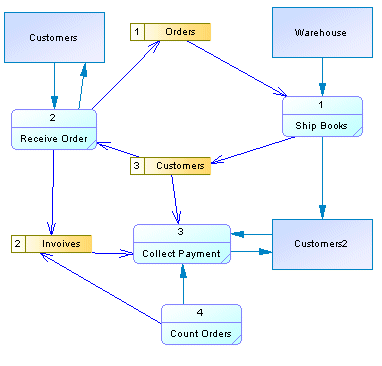

Chapter 21 Working with the Data Flow Diagram
The Data Flow Diagram (DFD) is a graphical representation of the flow of data through an information system. It enables you to represent the processes in your information system from the viewpoint of data. The DFD lets you visualize how the system operates, what the system accomplishes and how it will be implemented, when it is refined with further specification.
There are two types of DFDs:
Both types of data flow diagrams support a top-down approach to systems analysis, whereby analysts begin by developing a general understanding of the system and gradually explode components in greater details.
DFDs can also be grouped together to represent a sub-system of the system being analyzed.
A data flow diagram can look as follows:

Data flow diagrams are used by systems analysts to design information-processing systems but also as a way to model whole organizations.
The DFD is part of the Business Process Model. You create a data flow diagram using the Data Flow Diagram process language, which is part of the Analysis family. For more information, see "What is a BPM?" in the "Getting Started with the Business Process Model" chapter.
PowerDesigner DFD support:
You build a DFD at the very beginning of your business process modeling in order to model the functions your system has to carry out and the interaction between those functions together with focusing on data exchanges between processes. You can associate data with data models, such as Conceptual Data Models, Physical Data Models, or Object-Oriented Data Models.
This chapter outlines the specifics of PowerDesigner's support for data flow diagrams, and should be read in conjunction with the "Building Analysis Business Process Model" chapter in Part One of this book.
| Copyright (C) 2007. Sybase Inc. All rights reserved. |

| |